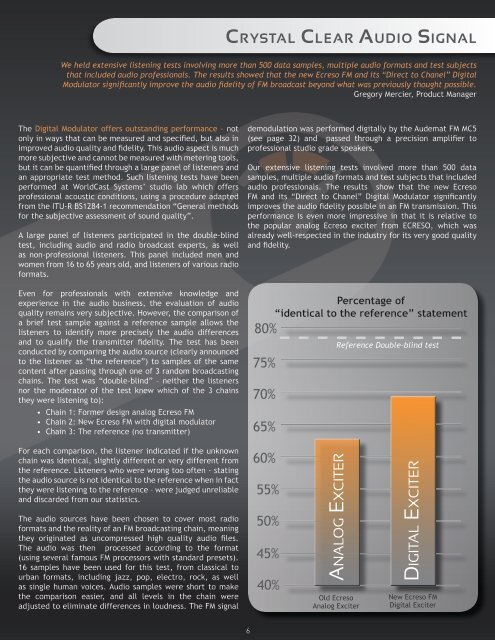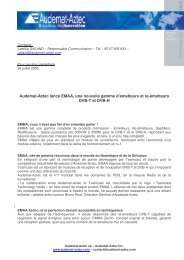FM TRANSMIT CATALOG - Ecreso
FM TRANSMIT CATALOG - Ecreso
FM TRANSMIT CATALOG - Ecreso
- No tags were found...
Create successful ePaper yourself
Turn your PDF publications into a flip-book with our unique Google optimized e-Paper software.
Crystal Clear Audio Signal<br />
We held extensive listening tests involving more than 500 data samples, multiple audio formats and test subjects<br />
that included audio professionals. The results showed that the new <strong>Ecreso</strong> <strong>FM</strong> and its “Direct to Chanel” Digital<br />
Modulator significantly improve the audio fidelity of <strong>FM</strong> broadcast beyond what was previously thought possible.<br />
Gregory Mercier, Product Manager<br />
The Digital Modulator offers outstanding performance – not<br />
only in ways that can be measured and specified, but also in<br />
improved audio quality and fidelity. This audio aspect is much<br />
more subjective and cannot be measured with metering tools,<br />
but it can be quantified through a large panel of listeners and<br />
an appropriate test method. Such listening tests have been<br />
performed at WorldCast Systems’ studio lab which offers<br />
professional acoustic conditions, using a procedure adapted<br />
from the ITU-R BS1284-1 recommendation “General methods<br />
for the subjective assessment of sound quality”.<br />
A large panel of listeners participated in the double-blind<br />
test, including audio and radio broadcast experts, as well<br />
as non-professional listeners. This panel included men and<br />
women from 16 to 65 years old, and listeners of various radio<br />
formats.<br />
Even for professionals with extensive knowledge and<br />
experience in the audio business, the evaluation of audio<br />
quality remains very subjective. However, the comparison of<br />
a brief test sample against a reference sample allows the<br />
listeners to identify more precisely the audio differences<br />
and to qualify the transmitter fidelity. The test has been<br />
conducted by comparing the audio source (clearly announced<br />
to the listener as “the reference”) to samples of the same<br />
content after passing through one of 3 random broadcasting<br />
chains. The test was “double-blind” – neither the listeners<br />
nor the moderator of the test knew which of the 3 chains<br />
they were listening to):<br />
• Chain 1: Former design analog <strong>Ecreso</strong> <strong>FM</strong><br />
• Chain 2: New <strong>Ecreso</strong> <strong>FM</strong> with digital modulator<br />
• Chain 3: The reference (no transmitter)<br />
demodulation was performed digitally by the Audemat <strong>FM</strong> MC5<br />
(see page 32) and passed through a precision amplifier to<br />
professional studio grade speakers.<br />
Our extensive listening tests involved more than 500 data<br />
samples, multiple audio formats and test subjects that included<br />
audio professionals. The results show that the new <strong>Ecreso</strong><br />
<strong>FM</strong> and its “Direct to Chanel” Digital Modulator significantly<br />
improves the audio fidelity possible in an <strong>FM</strong> transmission. This<br />
performance is even more impressive in that it is relative to<br />
the popular analog <strong>Ecreso</strong> exciter from ECRESO, which was<br />
already well-respected in the industry for its very good quality<br />
and fidelity.<br />
80%<br />
75%<br />
70%<br />
65%<br />
Percentage of<br />
“identical to the reference” statement<br />
Reference Double-blind test<br />
For each comparison, the listener indicated if the unknown<br />
chain was identical, slightly different or very different from<br />
the reference. Listeners who were wrong too often - stating<br />
the audio source is not identical to the reference when in fact<br />
they were listening to the reference – were judged unreliable<br />
and discarded from our statistics.<br />
The audio sources have been chosen to cover most radio<br />
formats and the reality of an <strong>FM</strong> broadcasting chain, meaning<br />
they originated as uncompressed high quality audio files.<br />
The audio was then processed according to the format<br />
(using several famous <strong>FM</strong> processors with standard presets).<br />
16 samples have been used for this test, from classical to<br />
urban formats, including jazz, pop, electro, rock, as well<br />
as single human voices. Audio samples were short to make<br />
the comparison easier, and all levels in the chain were<br />
adjusted to eliminate differences in loudness. The <strong>FM</strong> signal<br />
60%<br />
55%<br />
50%<br />
45%<br />
40%<br />
Analog Exciter<br />
Old <strong>Ecreso</strong><br />
Analog Exciter<br />
Digital Exciter<br />
New <strong>Ecreso</strong> <strong>FM</strong><br />
Digital Exciter<br />
6



